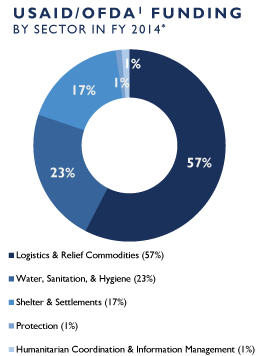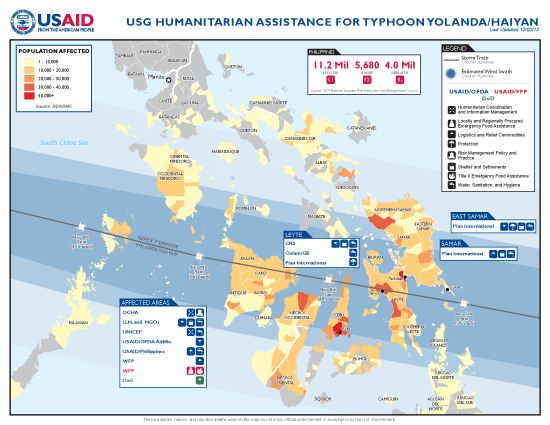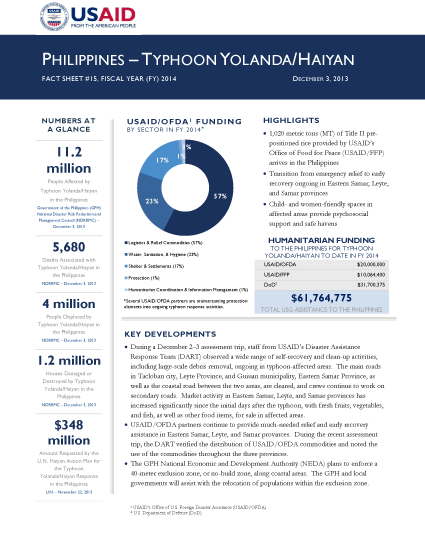- What We Do
- Agriculture and Food Security
- Democracy, Human Rights and Governance
- Economic Growth and Trade
- Education
- Ending Extreme Poverty
- Environment and Global Climate Change
- Gender Equality and Women's Empowerment
- Global Health
- Water and Sanitation
- Working in Crises and Conflict
- Disaster Assistance
- Political Transition Initiatives
- Conflict Mitigation and Prevention
- Countering Violent Extremism
- Disaster Risk Reduction
- Peacebuilding and Reconciliation
- Providing Safe & Secure Environments for Development
- Recovering From Crisis
- Resilience
- Tech Challenge for Atrocity Prevention
- World Humanitarian Day
- U.S. Global Development Lab
December 3, 2013
Numbers At A Glance
11.2 million
5,680
4 million
1.2 million
$348 million
Humanitarian Funding:
To The Philippines For Typhoon Haiyan/Yolanda To Date In FY2014:

| USAID/OFDA | $20,000,000 |
| USAID/FFP | $10,064,400 |
| DoD | $31,700,375 |
| TOTAL | $61,764,775 |
Typhoon Haiyan / Yolanda Fact Sheet #15 - 12/03/2013 ![]() (pdf - 239k)
(pdf - 239k)
Highlights
1,020 metric tons (MT) of Title II pre-positioned rice provided by USAID’s Office of Food for Peace (USAID/FFP) arrives in the Philippines.
Transition from emergency relief to early recovery ongoing in Eastern Samar, Leyte, and Samar provinces.
Child- and women-friendly spaces in affected areas provide psychosocial support and safe havens.
Key Developments
During a December 2–3 assessment trip, staff from USAID’s Disaster Assistance Response Team (DART) observed a wide range of self-recovery and clean-up activities, including large-scale debris removal, ongoing in typhoon-affected areas. The main roads in Tacloban city, Leyte Province, and Guiuan municipality, Eastern Samar Province, as well as the coastal road between the two areas, are cleared, and crews continue to work on secondary roads. Market activity in Eastern Samar, Leyte, and Samar provinces has increased significantly since the initial days after the typhoon, with fresh fruits, vegetables, and fish, as well as other food items, for sale in affected areas.
USAID/OFDA partners continue to provide much-needed relief and early recovery assistance in Eastern Samar, Leyte, and Samar provinces. During the recent assessment trip, the DART verified the distribution of USAID/OFDA commodities and noted the use of the commodities throughout the three provinces.
The GPH National Economic and Development Authority (NEDA) plans to enforce a 40-meter exclusion zone, or no-build zone, along coastal areas. The GPH and local governments will assist with the relocation of populations within the exclusion zone.
HEALTH AND WASH
- The Health Cluster—the coordinating body for health-related humanitarian activities in the Philippines—reports that acute respiratory infection, fever, diarrhea, hypertension, and skin disease are the five main causes of morbidity in affected areas. Additionally, the incidence of open wounds and bruises has increased in recent days due to ongoing debris-clearing activities, according to the U.N.
- Water, Sanitation, and Hygiene (WASH) Cluster partners warn of increased risks of disease outbreak as relief and recovery efforts continue. The GPH Department of Health (DoH) identified insecticide to prevent the spread of vector-borne diseases, including dengue fever and malaria, as an immediate need. Although partners continue to enhance disease surveillance capacity, gaps along the coast of Eastern Samar Province and in and around Ormoc city, Leyte Province, remain, in part due to damaged communication networks.
- Lack of adequate sanitation facilities and access to safe drinking water—compounded by overcrowding and unpredictable population movements—remain key concerns in evacuation centers. The U.N. reports that several water systems have tested positive for fecal coliform, likely resulting from open defecation.
- Between November 29 and December 3, WASH partners constructed 64 emergency latrines with hand-washing facilities for approximately 3,000 people. The DART WASH advisor reports that all evacuation centers in Tacloban housing more than 10 families have a non-governmental organization (NGO) focal point to ensure minimum sanitation and hygiene facilities are available.
- As of December 1, the joint DoH–U.N. World Health Organization vaccination campaign had covered 114 out of 138 barangays in Tacloban. Active in Leyte and Samar provinces, the campaign had vaccinated more than 6,400 children for measles and approximately 7,500 for polio. The campaign also provided doses of Vitamin A to nearly 5,800 children. The DoH reports that additional vaccine supplies, including syringes, refrigerators, and thermometers, are needed.
- Approximately 180 health teams—61 foreign and 118 local—are operating in affected areas, according to the U.N. As foreign medical teams begin to leave the Philippines, coordination and planning are required to ensure a smooth transition, according to the Health Cluster. At least 13 foreign medical teams had demobilized as of November 28.
PROTECTION
- The International Organization for Migration (IOM) Displacement Tracking Matrix (DTM) has identified 53 unaccompanied minors, who have been referred to the Protection Cluster. The DTM is monitoring approximately 31,200 people throughout 143 typhoon-affected municipalities.
- Child-friendly spaces in affected areas—including nine in Tacloban, three in Ormoc, and one in Estancia municipality, Iloilo Province—are providing psychosocial support and safe environments for typhoon-affected children.
- The GPH Department of Social Welfare and Development has established women-friendly spaces in several GPH-run evacuation centers in Tacloban to meet the special needs of women. Women who visit these spaces will receive psychosocial support, as well as medical care, reproductive health services, and basic food and relief items.
- The U.N. Office for the Coordination of Humanitarian Affairs (OCHA) reports a decrease in the number of people leaving Ormoc from 5,000 to 2,400 people daily. The Migration Outflow Desk in Ormoc is active, with 10 staff positioned at the airport, shipping port, and bus terminal to monitor population movements, according to IOM.
AGRICULTURE, FOOD SECURITY, AND LIVELIHOODS
- Recent assessments in Eastern Visayas Region indicate damage to more than 63,000 hectares of rice, or approximately 37 percent of the region’s rice production area, according to the Food Security and Agriculture Cluster (FSAC). OCHA reports that small-scale farmers continue to require immediate support to clean, clear, and plant their land and remove silt from communal irrigation canals for the current planting season.
- FSAC partners have procured and are distributing 36 percent of rice seed and 14 percent of corn seed required for the ongoing planting season in typhoon-affected areas, which ends in January. To date, FSAC partners have reached nearly 19,500 families with rice and corn seed for planting this season. In addition, FSAC partners are providing fertilizer and tools in areas where the GPH is distributing seed, reaching an additional 6,660 households to date.
- FSAC members have conducted livelihoods and market assessments to plan for livelihoods recovery projects and the transition to cash-based activities. OCHA reports that food distributions in moderately affected areas have begun to decrease slightly, with humanitarian organizations transitioning to income support and asset restoration activities.
- Humanitarian organizations will continue to target the most-vulnerable populations with food assistance. In the coming weeks, the U.N. World Food Program (WFP) plans to initiate a cash transfer program for approximately 85,000 people in Western Visayas Region, where markets are operational and financial delivery mechanisms are available.
- As of December 1, WFP had dispatched more than 4,320 MT of rice and 175 MT of high-energy biscuits for approximately 3 million people. WFP is preparing a second round of emergency food airlifts to several islands in Guiuan municipality, Eastern Samar Province, including Manicani, Tubabao, and Victory.
- On December 3, approximately 1,020 MT of Title II rice provided by USAID/FFP arrived in the Philippines for distribution to typhoon-affected populations. USAID/FFP shipped the rice—sufficient to feed 60,000 people for one month—from its pre-positioning warehouse in Colombo, Sri Lanka.
NUTRITION
- The Nutrition Cluster estimates that 1.35 million children under five years of age and 650,000 pregnant and lactating women across nine typhoon-affected regions are at risk of malnutrition, according to the U.N. Children’s Fund (UNICEF). To date, Nutrition Cluster partners have conducted malnutrition screening for more than 17,000 children, with 654 identified as suffering from acute malnutrition or at risk of acute malnutrition.
- In Iloilo and Capiz provinces, Western Visayas Region, Nutrition Cluster partners have screened approximately 3,450 children between six months and five years of age, with approximately 9 percent suffering from acute malnutrition or at risk of acute malnutrition. Of the 946 pregnant and lactating women screened, approximately 17 percent were also found to be acutely malnourished. In Central Visayas Region, partners identified 49 children under five suffering from severe acute malnutrition (SAM) and 162 children from moderate acute malnutrition (MAM). In Eastern Visayas Region, partners have detected 14 cases of SAM and 118 cases of MAM.
- Nutrition Cluster partners have enrolled all children identified as suffering from or at risk of acute malnutrition in treatment programs. In addition, cluster partners have provided nearly 1,000 pregnant and lactating women with nutrition support.
- WFP has initiated nutrition interventions in affected areas to prevent a rise in acute malnutrition. WFP plans to target children under five and pregnant and lactating women in evacuation centers with specialized nutrition products, such as Plumpy’Doz. WFP is providing nutrition information materials, written in the local language, along with the food products.
LOGISTICS AND RELIEF COMMODITIES
- The Logistics Cluster has transported more than 1,500 MT of relief items via air, road, and sea on behalf of 13 humanitarian organizations. On November 30 and December 1, the Logistics Cluster transported approximately 120 MT of relief items, including WASH and shelter materials, via military aircraft from Cebu to Tacloban, Roxas, Guiuan, and Ormoc.
- As of December 3, the U.N. Humanitarian Air Service had transported approximately 600 humanitarian personnel on more than 120 flights to Manila, Cebu, Ormoc, Roxas, Guiuan, Tacloban, and other affected areas.
- Despite continued improvements in logistics capacities, the Logistics Cluster reports that the Guiuan port is severely congested and road access in Guiuan is poor. Partners are currently assessing the nearby port of Barangai Molos.
- The WFP-contracted vessel MV Super Shuttle RoRo 5 arrived in Tacloban on November 29 carrying relief commodities for U.N. agencies and NGO partners. The vessel is currently returning to Cebu to reload with additional humanitarian cargo.
INTERNATIONAL ASSISTANCE
- As of December 3, international donors had pledged nearly $404 million to address the needs of populations affected by Typhoon Yolanda/Haiyan. The total amount pledged exceeds the $348 million requested by the revised U.N. Haiyan Action Plan for the Philippines typhoon response.
- The Office of the U.N. High Commissioner for Refugees (UNHCR) raised its emergency appeal for typhoon-affected populations from $8.3 million to $19.2 million, more than doubling its funding request. The additional funding will support the distribution of nearly 100,000 plastic sheets, 7,500 tents, 19,000 solar lanterns, and other relief commodities to populations in need.









Comment
Make a general inquiry or suggest an improvement.